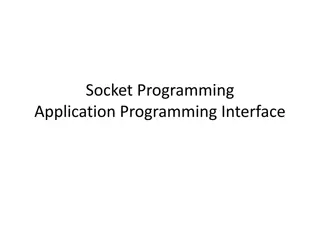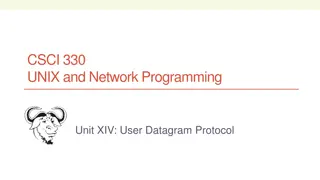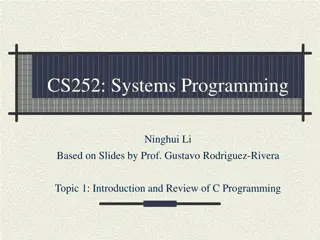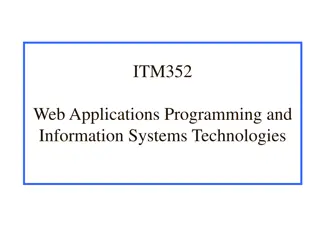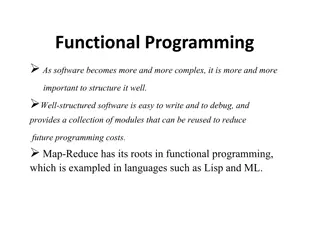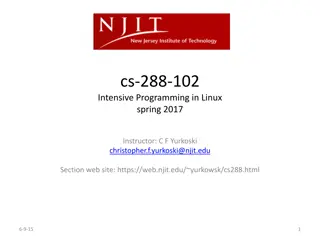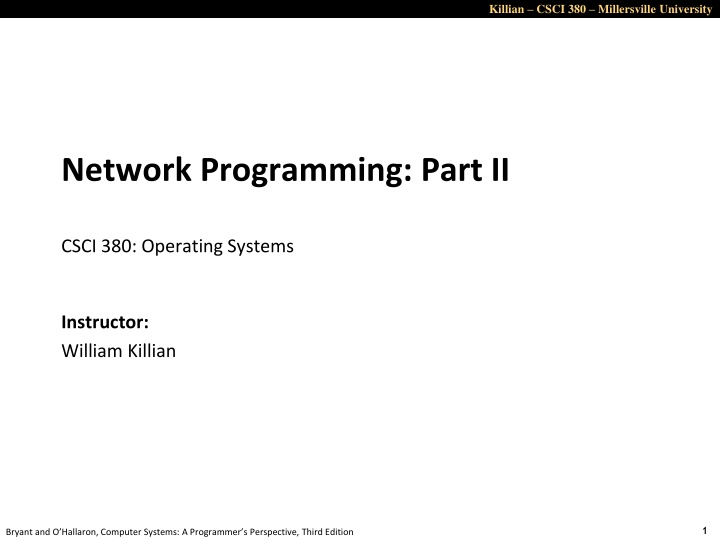
Millersville University Network Programming and Operating Systems Overview
"Explore network programming and operating systems concepts at Millersville University with a focus on sockets interface, client-server communication, and socket functions. Learn about creating socket descriptors and best practices for protocol independence."
Download Presentation

Please find below an Image/Link to download the presentation.
The content on the website is provided AS IS for your information and personal use only. It may not be sold, licensed, or shared on other websites without obtaining consent from the author. If you encounter any issues during the download, it is possible that the publisher has removed the file from their server.
You are allowed to download the files provided on this website for personal or commercial use, subject to the condition that they are used lawfully. All files are the property of their respective owners.
The content on the website is provided AS IS for your information and personal use only. It may not be sold, licensed, or shared on other websites without obtaining consent from the author.
E N D
Presentation Transcript
Killian CSCI 380 Millersville University Network Programming: Part II CSCI 380: Operating Systems Instructor: William Killian 1 Bryant and O Hallaron, Computer Systems: A Programmer s Perspective, Third Edition
Killian CSCI 380 Millersville University Sockets Interface 2. Start client Client 1. Start server Server getaddrinfo getaddrinfo socket socket open_listenfd open_clientfd bind listen Connection request connect accept 3. Exchange rio_writen rio_readlineb data Client / Server Session Await connection request from next client rio_readlineb rio_writen EOF rio_readlineb close 5. Drop client 4. Disconnect client close 2 Bryant and O Hallaron, Computer Systems: A Programmer s Perspective, Third Edition
Killian CSCI 380 Millersville University Sockets Interface Client Server getaddrinfo getaddrinfo socket socket open_listenfd open_clientfd bind listen Connection request connect accept rio_writen rio_readlineb Client / Server Session Await connection request from next client rio_readlineb rio_writen EOF rio_readlineb close close 3 Bryant and O Hallaron, Computer Systems: A Programmer s Perspective, Third Edition
Killian CSCI 380 Millersville University Sockets Interface: socket Clients and servers use the socket function to create a socket descriptor: int socket(int domain, int type, int protocol) Example: int clientfd = Socket(AF_INET, SOCK_STREAM, 0); Indicates that we are using 32-bit IPV4 addresses Indicates that the socket will be the end point of a connection Protocol specific! Best practice is to use getaddrinfo to generate the parameters automatically, so that code is protocol independent. 4 Bryant and O Hallaron, Computer Systems: A Programmer s Perspective, Third Edition
Killian CSCI 380 Millersville University Sockets Interface Client Server getaddrinfo getaddrinfo socket socket open_listenfd open_clientfd bind listen Connection request connect accept rio_writen rio_readlineb Client / Server Session Await connection request from next client rio_readlineb rio_writen EOF rio_readlineb close close 5 Bryant and O Hallaron, Computer Systems: A Programmer s Perspective, Third Edition
Killian CSCI 380 Millersville University Sockets Interface: bind A server uses bind to ask the kernel to associate the server s socket address with a socket descriptor: int bind(int sockfd, SA *addr, socklen_t addrlen); The process can read bytes that arrive on the connection whose endpoint is addr by reading from descriptor sockfd. Similarly, writes to sockfd are transferred along connection whose endpoint is addr. Best practice is to use getaddrinfo to supply the arguments addr and addrlen. 6 Bryant and O Hallaron, Computer Systems: A Programmer s Perspective, Third Edition
Killian CSCI 380 Millersville University Sockets Interface Client Server getaddrinfo getaddrinfo socket socket open_listenfd open_clientfd bind listen Connection request connect accept rio_writen rio_readlineb Client / Server Session Await connection request from next client rio_readlineb rio_writen EOF rio_readlineb close close 7 Bryant and O Hallaron, Computer Systems: A Programmer s Perspective, Third Edition
Killian CSCI 380 Millersville University Sockets Interface: listen By default, kernel assumes that descriptor from socket function is an active socket that will be on the client end of a connection. A server calls the listen function to tell the kernel that a descriptor will be used by a server rather than a client: int listen(int sockfd, int backlog); Converts sockfd from an active socket to a listening socket that can accept connection requests from clients. backlog is a hint about the number of outstanding connection requests that the kernel should queue up before starting to refuse requests. 8 Bryant and O Hallaron, Computer Systems: A Programmer s Perspective, Third Edition
Killian CSCI 380 Millersville University Sockets Interface Client Server getaddrinfo getaddrinfo socket socket open_listenfd open_clientfd bind listen Connection request connect accept rio_writen rio_readlineb Client / Server Session Await connection request from next client rio_readlineb rio_writen EOF rio_readlineb close close 9 Bryant and O Hallaron, Computer Systems: A Programmer s Perspective, Third Edition
Killian CSCI 380 Millersville University Sockets Interface: accept Servers wait for connection requests from clients by calling accept: int accept(int listenfd, SA *addr, int *addrlen); Waits for connection request to arrive on the connection bound to listenfd, then fills in client s socket address in addr and size of the socket address in addrlen. Returns a connected descriptor that can be used to communicate with the client via Unix I/O routines. 10 Bryant and O Hallaron, Computer Systems: A Programmer s Perspective, Third Edition
Killian CSCI 380 Millersville University Sockets Interface Client Server getaddrinfo getaddrinfo socket socket open_listenfd open_clientfd bind listen Connection request connect accept rio_writen rio_readlineb Client / Server Session Await connection request from next client rio_readlineb rio_writen EOF rio_readlineb close close 11 Bryant and O Hallaron, Computer Systems: A Programmer s Perspective, Third Edition
Killian CSCI 380 Millersville University Sockets Interface: connect A client establishes a connection with a server by calling connect: int connect(int clientfd, SA *addr, socklen_t addrlen); Attempts to establish a connection with server at socket address addr If successful, then clientfd is now ready for reading and writing. Resulting connection is characterized by socket pair (x:y, addr.sin_addr:addr.sin_port) x is client address y is ephemeral port that uniquely identifies client process on client host Best practice is to use getaddrinfo to supply the Bryant and O Hallaron, Computer Systems: A Programmer s Perspective, Third Edition arguments addr and addrlen. 12
Killian CSCI 380 Millersville University accept Illustrated listenfd(3) 1. Server blocks in accept, waiting for connection request on listening descriptor listenfd Client Server clientfd Connection request listenfd(3) 2. Client makes connection request by calling and blocking in connect Client Server clientfd listenfd(3) 3. Server returns connfd from accept. Client returns from connect. Connection is now established between clientfd and connfd Client Server clientfd connfd(4) 13 Bryant and O Hallaron, Computer Systems: A Programmer s Perspective, Third Edition
Killian CSCI 380 Millersville University Connected vs. Listening Descriptors Listening descriptor End point for client connection requests Created once and exists for lifetime of the server Connected descriptor End point of the connection between client and server A new descriptor is created each time the server accepts a connection request from a client Exists only as long as it takes to service client Why the distinction? Allows for concurrent servers that can communicate over many client connections simultaneously E.g., Each time we receive a new request, we fork a child to handle the request 14 Bryant and O Hallaron, Computer Systems: A Programmer s Perspective, Third Edition
Killian CSCI 380 Millersville University Sockets Interface Client Server getaddrinfo getaddrinfo socket socket open_listenfd open_clientfd bind listen Connection request connect accept rio_writen rio_readlineb Client / Server Session Await connection request from next client rio_readlineb rio_writen EOF rio_readlineb close close 15 Bryant and O Hallaron, Computer Systems: A Programmer s Perspective, Third Edition
Killian CSCI 380 Millersville University Sockets Interface Client Server getaddrinfo getaddrinfo socket socket open_listenfd open_clientfd bind listen Connection request connect accept rio_writen rio_readlineb Client / Server Session Await connection request from next client rio_readlineb rio_writen EOF rio_readlineb close close 16 Bryant and O Hallaron, Computer Systems: A Programmer s Perspective, Third Edition
Killian CSCI 380 Millersville University Sockets Helper: open_clientfd Establish a connection with a server int open_clientfd(char *hostname, char *port) { int clientfd; struct addrinfo hints, *listp, *p; /* Get a list of potential server addresses */ memset(&hints, 0, sizeof(struct addrinfo)); hints.ai_socktype = SOCK_STREAM; /* Open a connection */ hints.ai_flags = AI_NUMERICSERV; /* using numeric port arg. */ hints.ai_flags |= AI_ADDRCONFIG; /* Recommended for connections */ Getaddrinfo(hostname, port, &hints, &listp); csapp.c 17 Bryant and O Hallaron, Computer Systems: A Programmer s Perspective, Third Edition
Killian CSCI 380 Millersville University Sockets Helper: open_clientfd (cont) /* Walk the list for one that we can successfully connect to */ for (p = listp; p; p = p->ai_next) { /* Create a socket descriptor */ if ((clientfd = socket(p->ai_family, p->ai_socktype, p->ai_protocol)) < 0) continue; /* Socket failed, try the next */ /* Connect to the server */ if (connect(clientfd, p->ai_addr, p->ai_addrlen) != -1) break; /* Success */ Close(clientfd); /* Connect failed, try another */ } /* Clean up */ Freeaddrinfo(listp); if (!p) /* All connects failed */ return -1; else /* The last connect succeeded */ return clientfd; } csapp.c 18 Bryant and O Hallaron, Computer Systems: A Programmer s Perspective, Third Edition
Killian CSCI 380 Millersville University Sockets Interface Client Server getaddrinfo getaddrinfo socket socket open_listenfd open_clientfd bind listen Connection request connect accept rio_writen rio_readlineb Client / Server Session Await connection request from next client rio_readlineb rio_writen EOF rio_readlineb close close 19 Bryant and O Hallaron, Computer Systems: A Programmer s Perspective, Third Edition
Killian CSCI 380 Millersville University Sockets Helper: open_listenfd Create a listening descriptor that can be used to accept connection requests from clients. int open_listenfd(char *port) { struct addrinfo hints, *listp, *p; int listenfd, optval=1; /* Get a list of potential server addresses */ memset(&hints, 0, sizeof(struct addrinfo)); hints.ai_socktype = SOCK_STREAM; /* Accept connect. */ hints.ai_flags = AI_PASSIVE | AI_ADDRCONFIG; /* on any IP addr */ hints.ai_flags |= AI_NUMERICSERV; /* using port no. */ Getaddrinfo(NULL, port, &hints, &listp); csapp.c 20 Bryant and O Hallaron, Computer Systems: A Programmer s Perspective, Third Edition
Killian CSCI 380 Millersville University Sockets Helper: open_listenfd (cont) /* Walk the list for one that we can bind to */ for (p = listp; p; p = p->ai_next) { /* Create a socket descriptor */ if ((listenfd = socket(p->ai_family, p->ai_socktype, p->ai_protocol)) < 0) continue; /* Socket failed, try the next */ /* Eliminates "Address already in use" error from bind */ Setsockopt(listenfd, SOL_SOCKET, SO_REUSEADDR, (const void *)&optval , sizeof(int)); /* Bind the descriptor to the address */ if (bind(listenfd, p->ai_addr, p->ai_addrlen) == 0) break; /* Success */ Close(listenfd); /* Bind failed, try the next */ } csapp.c 21 Bryant and O Hallaron, Computer Systems: A Programmer s Perspective, Third Edition
Killian CSCI 380 Millersville University Sockets Helper: open_listenfd (cont) /* Clean up */ Freeaddrinfo(listp); if (!p) /* No address worked */ return -1; /* Make it a listening socket ready to accept conn. requests */ if (listen(listenfd, LISTENQ) < 0) { Close(listenfd); return -1; } return listenfd; } csapp.c Key point: open_clientfd and open_listenfd are both independent of any particular version of IP. 22 Bryant and O Hallaron, Computer Systems: A Programmer s Perspective, Third Edition
Killian CSCI 380 Millersville University Echo Client: Main Routine #include "csapp.h" int main(int argc, char **argv) { int clientfd; char *host, *port, buf[MAXLINE]; rio_t rio; host = argv[1]; port = argv[2]; clientfd = Open_clientfd(host, port); Rio_readinitb(&rio, clientfd); while (Fgets(buf, MAXLINE, stdin) != NULL) { Rio_writen(clientfd, buf, strlen(buf)); Rio_readlineb(&rio, buf, MAXLINE); Fputs(buf, stdout); } Close(clientfd); exit(0); } echoclient.c 23 Bryant and O Hallaron, Computer Systems: A Programmer s Perspective, Third Edition
Killian CSCI 380 Millersville University Iterative Echo Server: Main Routine #include "csapp.h void echo(int connfd); int main(int argc, char **argv) { int listenfd, connfd; socklen_t clientlen; struct sockaddr_storage clientaddr; /* Enough room for any addr */ char client_hostname[MAXLINE], client_port[MAXLINE]; listenfd = Open_listenfd(argv[1]); while (1) { clientlen = sizeof(struct sockaddr_storage); /* Important! */ connfd = Accept(listenfd, (SA *)&clientaddr, &clientlen); Getnameinfo((SA *) &clientaddr, clientlen, client_hostname, MAXLINE, client_port, MAXLINE, 0); printf("Connected to (%s, %s)\n", client_hostname, client_port); echo(connfd); Close(connfd); } exit(0); } echoserveri.c 24 Bryant and O Hallaron, Computer Systems: A Programmer s Perspective, Third Edition
Killian CSCI 380 Millersville University Echo Server: echo function The server uses RIO to read and echo text lines until EOF (end-of-file) condition is encountered. EOF condition caused by client calling close(clientfd) void echo(int connfd) { size_t n; char buf[MAXLINE]; rio_t rio; Rio_readinitb(&rio, connfd); while((n = Rio_readlineb(&rio, buf, MAXLINE)) != 0) { printf("server received %d bytes\n", (int)n); Rio_writen(connfd, buf, n); } } echo.c 25 Bryant and O Hallaron, Computer Systems: A Programmer s Perspective, Third Edition
Killian CSCI 380 Millersville University Testing Servers Using telnet The telnet program is invaluable for testing servers that transmit ASCII strings over Internet connections Our simple echo server Web servers Mail servers Usage: linux> telnet <host> <portnumber> Creates a connection with a server running on <host>and listening on port <portnumber> 26 Bryant and O Hallaron, Computer Systems: A Programmer s Perspective, Third Edition
Killian CSCI 380 Millersville University Testing the Echo Server With telnet whaleshark> ./echoserveri 15213 Connected to (MAKOSHARK.ICS.CS.CMU.EDU, 50280) server received 11 bytes server received 8 bytes makoshark> telnet whaleshark.ics.cs.cmu.edu 15213 Trying 128.2.210.175... Connected to whaleshark.ics.cs.cmu.edu (128.2.210.175). Escape character is '^]'. Hi there! Hi there! Howdy! Howdy! ^] telnet> quit Connection closed. makoshark> 27 Bryant and O Hallaron, Computer Systems: A Programmer s Perspective, Third Edition









